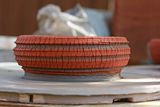You are using an out of date browser. It may not display this or other websites correctly.
You should upgrade or use an alternative browser.
You should upgrade or use an alternative browser.
greenware-- to post or not to post?
- Thread starter Boondock
- Start date
ketoi
Mame
Thanks for the critique Boon!
This was my 1st attempt of adding texture to a thrown pot, I'll have to post a photo of my texture tools in the tips thread.
Now the tough part, do glaze, stain or leave it raw? This is always the hardest part for me.
This was my 1st attempt of adding texture to a thrown pot, I'll have to post a photo of my texture tools in the tips thread.
Now the tough part, do glaze, stain or leave it raw? This is always the hardest part for me.
ketoi
Mame
Irene,
What I meant was it's always hard for me to decide on glaze color or scheme. After all the time and effort that goes into creating the pot I don't want to ruin it with a poor choice of color.
Although it is a lot easier if I making it for an intended plant as the examples below.

or stain

or just leave it the clay color

What I meant was it's always hard for me to decide on glaze color or scheme. After all the time and effort that goes into creating the pot I don't want to ruin it with a poor choice of color.
Although it is a lot easier if I making it for an intended plant as the examples below.

or stain

or just leave it the clay color

Boondock
Shohin
If it were mine, I'd bisque it, then dunk it in a pail (I use a 5 gallon bucket) of manganese dioxide wash, then sponge off as much as I can, leaving the oxide in the cracks.
Here's a pot I did this technique on, just to give you an idea of what it looks like. I think bonsaibiker uses a similar technique on some of his pots.

Here's a pot I did this technique on, just to give you an idea of what it looks like. I think bonsaibiker uses a similar technique on some of his pots.

Last edited:
Boondock
Shohin
Now the tough part, do glaze, stain or leave it raw?
Can you explain that?
Is there a color difference when they are fired?
Stains are a commercial product, that is a mixture of minerals and chemicals that when mixed with water, (or to a base glaze) can be applied to greenware or bisqueware. Mason is the most well known manufacturer of ceramic stains.
Here's is Mason's website so you can see the pallet of colors they offer.
Oxides are less refined minerals, usually not mixed with other stuff. Oxides can be minerals mined directly from the earth, wash and milled down to a fine powder. But some, like Red Iron Oxide, can be from recycled iron or steel. So your bonsai pot's surface might be from a 1972 Buick, lol.
ketoi
Mame
Thanks for the tip Boon!
How does manganese dioxide compare to black iron oxide?
How does manganese dioxide compare to black iron oxide?
ketoi
Mame
Boondock
Shohin
wow ketoi, these pots are fantastic. it reminds me of this

I'm headed to the pottery supply store in the next couple of days, and since sodium silicate is dirt cheap, and I already have a blow torch (like most bonsai folks have for annealing wire) I'm going to try this technique as well.

I'm headed to the pottery supply store in the next couple of days, and since sodium silicate is dirt cheap, and I already have a blow torch (like most bonsai folks have for annealing wire) I'm going to try this technique as well.
ketoi
Mame
bonsaibiker
Seedling
- Messages
- 15
- Reaction score
- 0
Nice start at making crackpots there Ketoi ! I like them so far, keep it up.
Similar threads
- Replies
- 20
- Views
- 595







